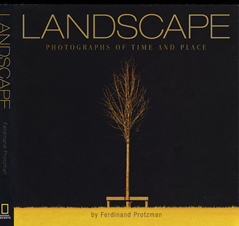


 |
Issue Contents :: Bookshelf :: Page [ 1 2 ]
Featured Book
Landscape: Photographs
of Time and Place
By Ferdinand Protzman '75
National Geographic, 2003
 |
Near the end of his photo essay on the landscape, cultural writer and critic Ferdinand Protzman states: "The three central elements of landscape photography–time, place, and people–cannot be fixed forever …Sooner or later, pictures and people will melt into nothingness." In his travelogue of the world landscape–defined no longer as just sunsets and scenic vistas–Protzman considers the changing perception of what landscapes are. Through the compelling works of 84 photographers spanning 150 years, Protzman redefines landscape photography as the intersection of time, place, and people.
The images, both color and black and white, are carefully arranged into eight chapters that explore such themes as the human presence in the landscape and the history of landscape in painting and photography. Also included are short essays by Protzman on how rural and urban landscape have been documented through photography over the years. This is Protzman's vision of an ever-changing landscape, and he is well prepared and equipped to record the account.
In the course of his discovery and accumulation of images and narratives, Protzman refers to his childhood "arcadia" in central Illinois, for him a place transformed by memory, distance, and imagination. There, in the small industrial city of Decatur and its environs are the seeds for his stories: "an idealized landscape, a patchwork pieced together from memories." In his own attempt to document this personal terrain, Protzman found himself confronted by the same challenges faced by the landscape photographer.
With such a wide range of photographers represented in the publication, one does wish for short biographies and more information about the images, particularly the photographic techniques employed. But as much as the book reads like an anthology, it is, in fact, a diary, and this is where Protzman's genius as a journalist comes through. The brief entries that accompany each image give us insight into the photographer's intentions and Protzman's own rationale for including the work.
In an era saturated with oversized, flashy, coffee-table publications, this compact edition of photographs (9" x 9") may disappoint some readers, but it will likely delight many more, particularly when viewed as a traveler's guide to the world. The journey is by foot and car, air and sea, and marked with the pictorial resources of one well-versed in the visual languages of the globe. Protzman shows us a world developing, changing, retreating, and advancing–a landscape of every hue and every human emotion and condition. This is the world landscape as only a photographer can show, and the author has found some of the finest for this gripping presentation.
Stephen D. Borys is curator of western art and acting curator of modern and contemporary art at Oberlin's Allen Memorial Art Museum.
Next Page >>